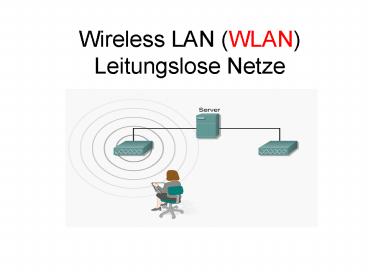Wireless LAN WLAN Leitungslose Netze - PowerPoint PPT Presentation
1 / 12
Title:
Wireless LAN WLAN Leitungslose Netze
Description:
WLANs use CSMA/CA. Carrier Sense Multiple. Access / Collision Avoidance (EEEI 802.11b ) (Ethernet CSMA/CD ) WEP Wired equivalence privacy. Sicherheitsemchanismus ... – PowerPoint PPT presentation
Number of Views:43
Avg rating:3.0/5.0
Title: Wireless LAN WLAN Leitungslose Netze
1
Wireless LAN (WLAN) Leitungslose Netze
2
Verbindung zwischen Gebäude
3
Komponenten im WLAN
USB-NIC
PCMCIA NIC
PC-NIC
Access-Point AP
Compatibility problems with NICs are solved by
installing an Access Point (AP) to act as a
central hub for the WLAN
4
Modulationsarten
Radio und TV
Für WLAN
Frequenz 2,5 GHz, 5 GHz
5
Übertragungsarten
- Direct Sequence Spread Spectrum (DSSS)Ein Bit
wird durch eine Chipping-Sequenz dargestellt
(bis 11 Mbps) - Frequency Hopping Spread Spectrum (FHSS)
Wechselt während Übertragung die
Übertragungs-Frequenzen(bis 2 Mbps)
6
Mehrere APs
Most commonly, the range will be from 91.44 to
152.4 meters
The overlap permits "roaming" between cells.
7
Zusammenhang zwischen Entfernung zum AP und der
Übertragungsrate
Performance of the network will also be affected
by signal strength and degradation in signal
quality due to distance or interference. As the
signal becomes weaker, Adaptive Rate Selection
(ARS) may be invoked. The transmitting unit will
drop the data rate from 11 Mbps to 5.5 Mbps, from
5.5 Mbps to 2 Mbps or 2 Mbps to 1 Mbps.
8
Zugriffsart und Frames
- Three types of frames
- are used in wireless
- communication
- control, management, and
- data
- WLANs use CSMA/CA
- Carrier Sense Multiple
- Access /
- Collision Avoidance
- (EEEI 802.11b )
- (Ethernet CSMA/CD )
9
WEP Wired equivalence privacy
- Sicherheitsemchanismus nach 802.11
- Standard
- Ziele
- Deny access by unauthorized users
- Prevent the decoding of WLAN traffic
10
Authentication types
WLAN authentication is a process that
authenticates the device, not the user
11
Authentication and Association types
- Unauthenticated and unassociated The node is
disconnected from the network and not associated
to an access point. - Authenticated and unassociated The node has
been authenticated on the network but has not yet
associated with the access point. - Authenticated and associated The node is
connected to the network and able to transmit and
receive data through the access point.
12
Wireless security
- EAP-MD5 Challenge Extensible Authentication
Protocol is the earliest authentication type,
which is very similar to CHAP password protection
on a wired network. - LEAP (Cisco) Lightweight Extensible
Authentication Protocol is the type primarily
used on Cisco WLAN access points. LEAP provides
security during credential exchange, encrypts
using dynamic WEP keys, and supports mutual
authentication. - User authentication Allows only authorized
users to connect, send and receive data over the
wireless network. - Encryption Provides encryption services further
protecting the data from intruders. - Data authentication Ensures the integrity of
the data, authenticating source and destination
devices.































